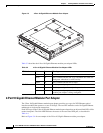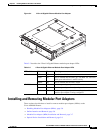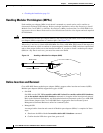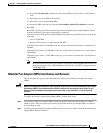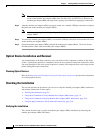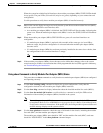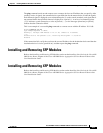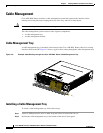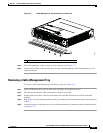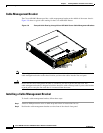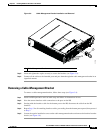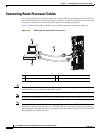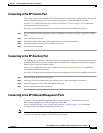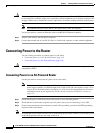
3-11
Cisco ASR 9001 and Cisco ASR 9001-S Routers Hardware Installation Guide
OL-26701-02
Chapter 3 Installing Modules and Cables in the Chassis
Installing and Removing SFP Modules
The ping command sends an echo request out to a remote device at an IP address that you specify. After
sending a series of signals, the command waits a specified time for the remote device to echo the signals.
Each returned signal is displayed as an exclamation point (!) on the console terminal; each signal that is
not returned before the specified timeout is displayed as a period (.). A series of exclamation points
(!!!!!) indicates a good connection; a series of periods (.....) or the messages [timed out] or [failed]
indicate that the connection failed.
This is an example of a successful ping command to a remote server with the IP address 10.1.1.60:
Router# ping 10.1.1.60
Type escape sequence to abort.
Sending 5, 100-byte ICMP Echoes to 10.1.1.60, timeout is 2 seconds:
!!!!!
Success rate is 100 percent (5/5), round-trip min/avg/max = 1/15/64 ms
Router#
If the connection fails, verify that you have the correct IP address for the destination device and that the
destination device is active (powered on), and then repeat the ping command.
Installing and Removing SFP Modules
Refer to the Installing and Removing SFP Modules section on the Installing Line Cards in the Cisco ASR
9000 Series Router chapter of the Cisco ASR 9000 Series Aggregation Services Router Ethernet Line
Card Installation Guide.
Installing and Removing XFP Modules
Refer to the Installing and Removing XFP Modules section on the Installing Line Cards in the Cisco ASR
9000 Series Router chapter of the Cisco ASR 9000 Series Aggregation Services Router Ethernet Line
Card Installation Guide.




